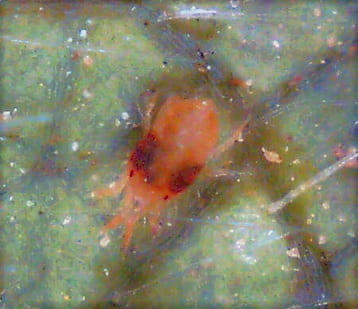By Jerry Brust, UME
With the cooler weather we have had of late I was surprised to find low levels of mites in strawberry fields, with a few hot spots of mites in some high tunnels. There were two species of mites found: the two spotted spider mite, Tetranychus urticae and the cyclamen mite Phytonemus pallidus.

Overwintering female two spotted spider mites are an orangish-red (Fig. 1) and most of the mites that can be seen with a naked eye will appear reddish in color. Spider mites overwinter in the soil or leaf litter, although they may remain somewhat active in high tunnels through the winter. The light yellowish eggs are pearl-like in appearance and are attached to the undersides of leaves or stems. Feeding damage by mites that occurs before fruiting can cause the most loss in yield, but after the first strawberry harvest plants can tolerate much greater rates of infestation. Growers should check their strawberries for mites now, especially if you have them in a high tunnel. If mites are found now you need more than 5 mites per leaflet (1/3 of a leaf) to justify the expense of a miticide application.
The most difficult thing to achieve for good control is getting adequate spray coverage. Many of the spray applications do a good job of covering the top of the leaves but do a poor job of reaching the underside of the trifoliate. The underside area of the leaf that usually sees very little chemical deposition is in the ‘palm’ of the leaf. These are the areas where mites can still be found even after a few sprays and need to be carefully checked a few days after an application. Good coverage is essential. Using two horticulture oil applications about one week apart it is possible to control not only the adults and nymphs, but the eggs too. Oil is a good management tactic to use at this time of year as the plants are small and any possible burn from using the oil is a very low risk. Using oils now also will greatly reduce any development of mite resistance to other chemicals over the course of the season. If miticides are needed there are many excellent miticides that can be found in the Mid-Atlantic Commercial Vegetable Production Recommendations guide for strawberries.

Adult cyclamen mites are usually never seen as they are only a quarter of a mm long and a 20X hand lens or dissecting microscope is needed to see them. And unlike two spotted spider mites that prefer dry conditions, cyclamen mites thrive in humid conditions. Adult mites are oval-shaped and a glossy creamy orange (Fig. 2) with males being smaller than females. The eggs are translucent and comparatively large, about 40% the size of an adult (Fig. 2). Female adults overwinter in strawberry crowns and also can be present on transplants. Female mites lay their eggs on strawberry leaves that hatch into tiny, white, six-legged larvae (Fig. 2). The entire life cycle of the cyclamen mite is less than 3 weeks and therefore populations can build quickly. Although there are multiple generations each year, populations tend to peak in spring and again in late summer.

Cyclamen mites use their piercing-sucking mouthparts to feed on plant material. Symptoms of infestation can be found throughout the plant. However, at low numbers cyclamen mites usually are found along the midvein of young, unfolded leaves and under the calyx of newly emerged flower buds. As numbers increase mites can be found anywhere on the plant. The infested leaves will appear stunted and crumpled (Fig. 3), while flowers wither and die and fruit becomes shrunken with protruding seeds (Fig. 4). By the time these symptoms appear, it is too late to limit damage, so cyclamen mites should be managed preventively. Treatments should be applied when 1 leaf in 10 shows cyclamen mite infestation.

Growers should watch for infested deformed leaves starting when new buds emerge from the crown and continuing until harvest. Older fields will most likely have more problems. In order to be sure of the presence of cyclamen mite, you need to examine the newest leaves in the crown, specifically the mid vein and lower part of a leaf where it joins the petiole. Magnification (20-40X) is recommended for confirmation of cyclamen mites.
Early detection of cyclamen mites is essential in achieving best control, which means detection early in the growing season when foliage is nominal. Thorough spray coverage of the crown leaves is important for good control. Horticultural oils can be used if temperatures are below 88o F. Agri-Mek SC or Portal also can be used for mite control. Predatory mites can be used and work best if cyclamen mite populations are small and confined to scattered hot-spots in a field.
